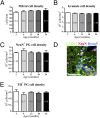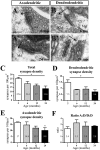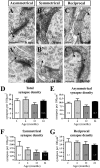Age-induced disruption of selective olfactory bulb synaptic circuits
- PMID: 20679234
- PMCID: PMC2932573
- DOI: 10.1073/pnas.1007931107
Age-induced disruption of selective olfactory bulb synaptic circuits
Abstract
Little is known about how normal aging affects the brain. Recent evidence suggests that neuronal loss is not ubiquitous in aging neocortex. Instead, subtle and still controversial, region- and layer-specific alterations of neuron morphology and synapses are reported during aging, leading to the notion that discrete changes in neural circuitry may underlie age-related cognitive deficits. Although deficits in sensory function suggest that primary sensory cortices are affected by aging, our understanding of the age-related cellular and molecular changes is sparse. To assess the effect of aging on the organization of olfactory bulb (OB) circuitry, we carried out quantitative morphometric analyses in the mouse OB at 2, 6, 12, 18, and 24 mo. Our data establish that the volumes of the major OB layers do not change during aging. Parallel to this, we are unique in demonstrating that the stereotypic glomerular convergence of M72-GFP OSN axons in the OB is preserved during aging. We then provide unique evidence of the stability of projection neurons and interneurons subpopulations in the aging mouse OB, arguing against the notion of an age-dependent widespread loss of neurons. Finally, we show ultrastructurally a significant layer-specific loss of synapses; synaptic density is reduced in the glomerular layer but not the external plexiform layer, leading to an imbalance in OB circuitry. These results suggest that reduction of afferent synaptic input and local modulatory circuit synapses in OB glomeruli may contribute to specific age-related alterations of the olfactory function.
Conflict of interest statement
The authors declare no conflict of interest.
Figures






Comment in
-
The brain's fight against aging.Proc Natl Acad Sci U S A. 2010 Aug 31;107(35):15316-7. doi: 10.1073/pnas.1010574107. Epub 2010 Aug 24. Proc Natl Acad Sci U S A. 2010. PMID: 20736352 Free PMC article. No abstract available.
References
-
- Kraemer S, Apfelbach R. Olfactory sensitivity, learning and cognition in young adult and aged male Wistar rats. Physiol Behav. 2004;81:435–442. - PubMed
-
- Apfelbach R, Russ D, Slotnick BM. Ontogenic changes in odor sensitivity, olfactory receptor area and olfactroy receptor density in the rat. Chem Senses. 1991;16:209–218.
-
- Schoenbaum G, Nugent S, Saddoris MP, Gallagher M. Teaching old rats new tricks: Age-related impairments in olfactory reversal learning. Neurobiol Aging. 2002;23:555–564. - PubMed
Publication types
MeSH terms
Substances
Grants and funding
LinkOut - more resources
Full Text Sources
Medical
Miscellaneous

